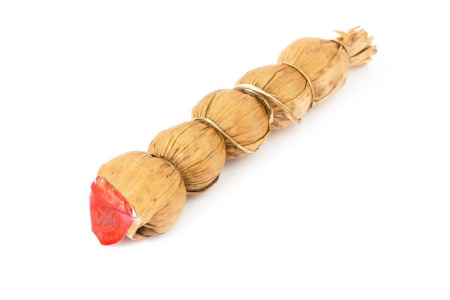-
10 Saturation
-
10 Aftertaste
-
10 Aroma
-
10 Effect
-
10 Balance
-
10 Body
Чёрный чай Чжукэ Ча или чай в бамбуковой оболочке
Наименование: Чжукэ Ча
Перевод: чай в бамбуковой коробочке
Кит. 竹壳茶, пиньинь zhú qiào chá
Первоначальное название: Тыквенный чай (кит. 葫芦茶, пиньинь húluchá), также его называют чаем от простуды.
Дата изготовления: 2014 год.
Примерный вес: 25 грамм.
Производитель: чайный завод Цзыцзинь ланьтан таожань чжукэ Гуандун, округ Хэюань (кит. 广东河源紫金蓝塘陶然竹壳茶厂, пиньинь Guangdong heyuan zijin lantang taoran zhuke chachang).
Происхождение: городской округ Хэюань, провинция Гуандун.
Китайцы, живущие за границей, называют его чай даосского отшельника. Он имеет 400-летную историю и состоит из более 10 редких лекарственных трав, собираемых в глухих лесах. Производится по специальной технологии. Обычно упаковывается в бамбуковую коробочку или тыкву горлянку (лат. Lagenária sicerária). И это неспроста, ведь тыква горлянка является символом врачей в древнем Китае, так как в ней раньше хранили лекарства.
Чай имеет приятный вкус и сладкий аромат. Является одним из самых любимых прохладный/холодных чаёв провинции Гуандун. Обладает прекрасными свойствами: облегчает состояние организма в жару, способствует пищеварению, защищает от насекомых-вредителей (жители Гуандуна добавляют его при засолке рыбы и приготовлении мяса). Чай используют для лечения болей в горле, кашля, болезней легких, в том числе туберкулёза, расстройств кишечника, ломоты в суставах при ревматизме, склеродермии, токсикоза беременных и заболеваний в послеродовой период, нарывов и крапивницы.
Внешне чай в сухом виде выглядит разнообразно: с черешками и древесными компонентами. Обладает перечным ароматом. Вкус древесно-пряный и слегка острый, но последнее не доминирует, зато создаёт приятную шероховатость в горле.
Другие хэйча в интернет-магазине Чайная Линия.
Впервые опубликовано 07.12.2014.
Copyright © Chaline.Ru
|
Name in Chinese
|
竹壳茶 |
|
Pinyin
|
zhú qiào chá |
|
Translation
|
tea in a bamboo box |
|
Country
|
China |
|
District
|
Heyuan |
|
Provinces
|
Гуандун (广东) |
|
Region
|
Fenghuang (凤凰) |
|
Raw material production date
|
2014 |
|
Year of pressing
|
2014 |
|
Declared weight, g
|
25 |
- Reviews
- Vkontakte
Pu-erh is one of the most unique types of tea, which only gets better with age. Many people, when they first encounter this tea, wondered: why is pu-erh more often found in pressed form (cakes, bricks, tochas), and not in loose form? The reasons for this are related to both history and the practical aspects of storing and fermenting tea. Despite modern technologies that allow the production of loose pu-erh, the shape of pressed cakes remains unchanged. And pu-erh is more often found on sale in pressed form, for example, in the form of cakes or bricks, and loose pu-erh is less common. We will talk about the reasons for pressing pu-erh into cakes in this article.
Puer is a unique Chinese tea that is distinguished by its depth of taste, complexity of aromas and versatility of aftertaste. Its taste characteristics are formed under the influence of many factors, from growing conditions to the brewing method. Let's look at the main ones.
In the world of tea, where every leaf holds a thousand-year history, there is one special drink whose origin is shrouded in mystery and wonder. This is Heicha, a dark tea that not only captivates with its deep taste, but also has an amazing story associated with rain, despair, and a miracle of healing.



















































































